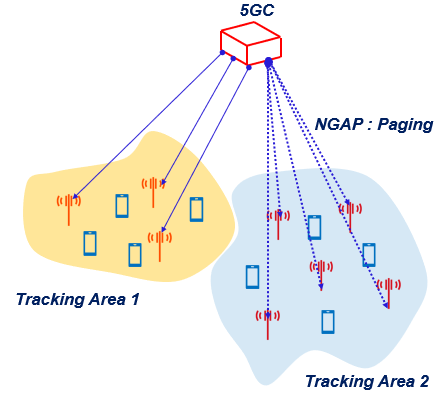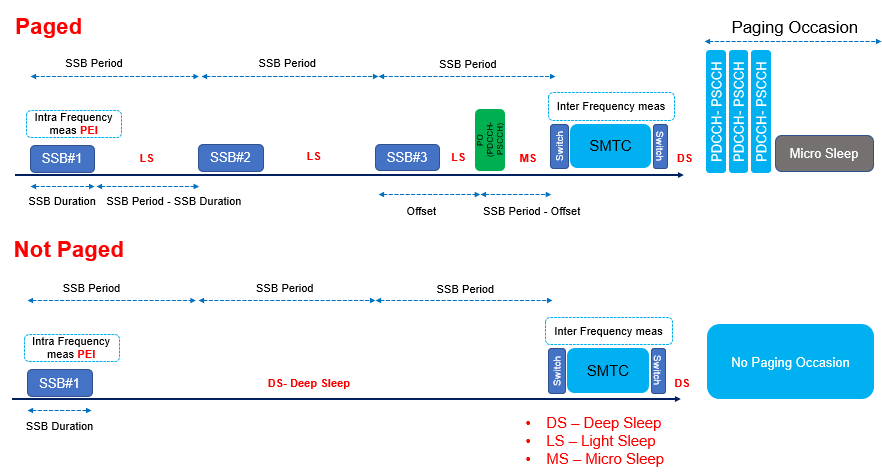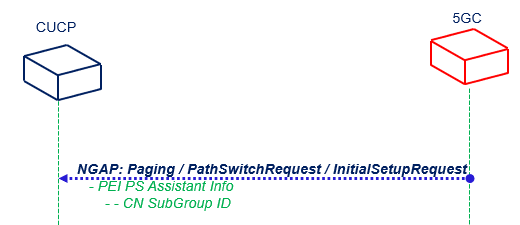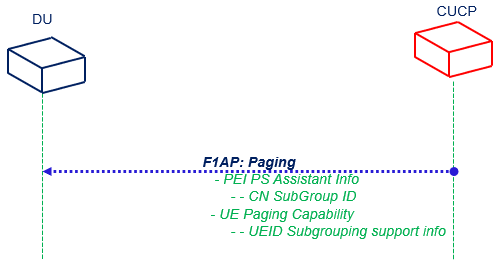Early Paging Indication | 3GPP Release 17
Introduction
3GPP release 17 for 5G NR, introduced the paging enhancements for UE Power Saving, the enhancement is named as Early Paging Indication (EPI). In earlier release 15, in high false paging or very rare paging scenario UE may consume high power results in fast battery drain.

The concept of Early Paging Indication (EPI), where a UE is notified in advance of its Paging Occasion (PO), whether the UE has to monitor. As a result of this, UE can skip the time-frequency synchronization prior to a PO, if the UE need not monitor the PO. The EPI can be signaled via a Downlink Control Information (DCI) message carried in the Physical Downlink Control Channel or via a Reference Signal, e.g. the Secondary Synchronization Signal.
Another important thing with EPI is that it may carry sub-grouping information to divide the UEs, sharing the same Paging Occasion, into sub-groups. This results in lower group paging rate and fewer false paging alarms.
Key Pointers
- Early Paging Indication feature is introduced in 3GPP release 17 as an enhancement to traditional Paging
- It helps in saving the UE power exhausted in decoding false Paging messages
- In EPI, UE is notified in advance of its Paging Occasion (PO)
- EPI can be signaled via a DCI or via a Reference Signal
- Simulations has shown that EPI can lead to 17 %-34 % energy savings as compared to the release 15 basic paging procedure, depending on the UE SINR radio conditions.
- If the EPI is complemented with sub-group information an additional 10 % energy can be saved, while also mitigating the impact of high group paging rates
- SIB 1 is used to inform UE about EPI config as PEI-config IE
DCI-based Early Paging Indication (EPI)
The DCI-based EPI can flexibly contain the sub-group indication, and potentially also Short Message and other
information, and is therefore the preferred option. The EPI implies a limited-size DCI search space or a sequence, transmitted from the gNB prior to each Paging Occasion.
IDLE/Inactive UEs monitor the search space of the EPI, and upon detection of a present EPI indication, the UEs monitor the next PO. Otherwise, the UEs /deep sleep and skip detecting the PO. The achievable power saving gain is due to the more limited EPI search space, compared to the actual paging PDCCH. Hence, the EPI reduces the number of unneeded Paging Occasion decoding, i.e. reducing paging false alarms, for UEs which are not paged.

Furthermore, the EPI DCI or sequence could be defined for a certain group of IDLE/Inactive UEs. Particularly, IDLE/Inactive UEs are sub-grouped in several paging groups, by several introduced grouping means, and the EPI DCI is scrambled in a group-specific manner. Thus, when an IDLE/inactive mode UE calculates a wrong cyclic redundancy check (CRC) after decoding the EPI DCI with its own paging-group scrambling code, it assumes that
the transmitted EPI is meant for one or more of the other paging groups, and accordingly skips the PO, leading to a further reduction of the paging false alarms .
Paging Enhancements by 3GPP
- Early Paging Indication (EPI): informs the UE whether to receive the next PO. Therefore, the UE can determine whether to prepare for PO reception by monitoring the needed SSB burst, as illustrated in above figure. Otherwise the UE may sleep until it needs to perform inter-frequency measurements (not needed in case of high SINR UEs). The EPI may e.g. be signaled using: – RRC Connected wake-up signal DCI (format 2 6) – Paging DCI (format 1 0) – a sequence, e.g. Secondary Synchronization Signal (SSS) or Tracking Reference Signal (TRS) The power saving potential of EPI resides in the reduction of SSB burst monitoring and PDCCH+PDSCH reception and as a consequence the increased sleeping time.
- Sub-grouping: due to many UEs may share the same PO, the false paging alarm rate may be high. Sub-grouping enables dividing the UEs of one PO in N sub-groups in order to minimize the false paging alarm.
- Cross-slot scheduling: this paging enhancement introduces a delay K0 between the scheduling information contained in the PDCCH (the PO) and the paging message carried in the PDSCH, allowing the UE to read the PDSCH only when there is a paging message for it.
Subgrouping
UE power saving for paging monitoring: In order to reduce UE power consumption due to false paging alarms, the group of UEs monitoring the same PO can be further divided into multiple subgroups. With subgrouping, a UE shall monitor PDCCH in its PO for paging if the subgroup to which the UE belongs is paged as indicated via associated PEI. If a UE cannot find its subgroup ID with the PEI configurations in a cell or if the UE is unable to monitor the associated PEI occasion corresponding to its PO, it shall monitor the paging in its PO.
-
- CN Subgrouping
- UE based Subgrouping
- CN controlled subgrouping: AMF is responsible for assigning subgroup ID to the UE. The total number of subgroups for CN controlled subgrouping can be configured up to 8, e.g. by OAM. The following figure describes the procedure for CN controlled subgrouping:

-
-
- The UE indicates its support of CN controlled subgrouping via NAS signaling.
- If the UE supports CN controlled subgrouping, the AMF determines the subgroup ID assignment for the UE.
- The AMF sends subgroup ID to the UE via NAS signaling.
- The AMF informs the gNB about the assigned subgroup ID for paging the UE in RRC_IDLE / RRC_INACTIVE state
- When the paging message for the UE is received from the CN or is generated by the gNB, the gNB determines the PO and the associated PEI occasion for the UE.
- Before the UE is paged in the PO, the gNB transmits the associated PEI and indicates the subgroup(s) of the UE(s) that is paged in the PEI if supported by the UE(s).
-
- UE ID based subgrouping: gNB and UE can determine the subgroup ID based on the UE ID and the total number of subgroups for UE ID based subgrouping in the cell. The total number of subgroups for UE ID based subgrouping is decided by the gNB for each cell and can be different in different cells. The following figure describes the procedure for UE ID based subgrouping:

-
-
- The gNB determines the total number of subgroups for UE ID based subgrouping in a cell
- The gNB broadcasts the total number of subgroups for UE ID based subgrouping in a cell
- When paging message for the UE is received from the CN to the gNB or is generated by the gNB, the gNB determines the PO and the associated PEI occasion for the UE
- Before the UE is paged in the PO, the gNB transmits the associated PEI and indicates the subgroup(s) of the UE(s) that is paged in the PEI if supported by the UE(s)
-
Early Paging Indication impact Analysis
- In SIB1 , PEI-config related information is transmitted . It contains information related with PEI search space, DCI 2_7 information, SS indexing, UE based subgrouping info and other relevant information to configure PEI and subgrouping on UE side and on gNB Lower Layers .

- 5GC share PEI related info in NG InitialContextSetupRequest / PathSwitchRequest / Paging messages with CUCP

- F1AP requires PEI related subgrouping information provided in Paging or SIB1 message

- UE inform PEI and subgrouping support in RegistrationRequest. 5GC inform support about CN SubGrouping in RegistrationAccept

References:
- 3GPP TS 38.331: 5G NR, Radio Resource Control (RRC)
Related Posts:
- 5G NR Beam Failure Recovery – BFR
- 5G NR RRC State Transitions
- 5G NR RRC Timers, Counter and Constants
